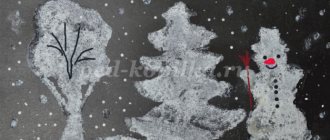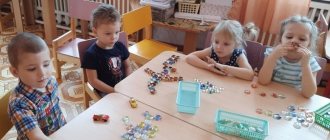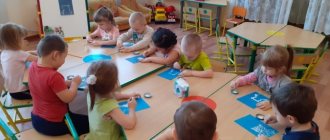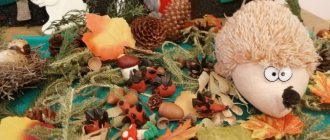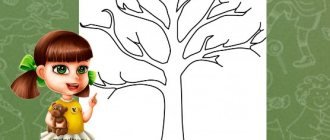Notes on art and art (drawing) in the second junior group on the topic: “Baby books.”
Abstract of the GCD in fine art (drawing) in the 2nd junior group on the topic: “Baby books.”
Prepared by Moskaleva L.V., teacher at MBDOU d/s No. 21, Novocherkassk, 2020.
Target.
Develop the ability to draw a square, quadrilateral with continuous hand movements.
Tasks.
· Practice shading in different ways (top to bottom or left to right).
· Develop creativity and imagination.
· Foster independence
Preliminary work.
· Examining and reading, noting the shape and brightness of their design by illustrators.
· In their free time, teaching children to trace square and rectangular objects along the contour with continuous movements, fixing the rotation of the hand at each corner.
Material.
· Album sheets,
· colored pencils and wax crayons,
· a selection of books for children.
GCD move
There's a knock on the door.
The storyteller grandmother enters. There is no chest in his hands.
V. - Guys, look who came to visit us. This is grandma, a storyteller.
Grandmother greets the children.
B. - Guys, do you like fairy tales? What fairy tales do you know? Children's answers.
B.- But I came to you not empty-handed. Look what I brought you.
Grandma takes baby books out of her chest.
We all look at books together.
V.- Guys, tell me, are the books big or small? That’s right, the books are small.
-That’s why they are called baby books.
-And, do you want to make such books yourself?
-What shape are they? (quadrangle).
-Now we will draw a quadrangle in the air.
Children draw in the air, clearly drawing the lines of the sides of the quadrangle.
But before we get to work, let's take a little rest.
Next, on the easel, show again how to draw a quadrangle (we start with a line, which we draw from left to right, then from top to bottom, from right to left and from bottom to top). Draw children's attention to how it is necessary to clearly draw the corners. Practice drawing a quadrilateral in the air again.
V. - Guys, before we start work, we will make a baby book from a landscape sheet. To do this, we need to fold the sheet in half, connect the corners and opposite sides of the sheet, iron the fold line with our hand.
On each page, children draw quadrilaterals; at this time, monitor the correctness of the form-building movements. When the children finish drawing, ask them to color it.
V. - Guys, now we will remember the methods of painting (from top to bottom or from left to right).
At the end of the lesson, we all look at the books together.
B. - Guys, how beautiful and different your books turned out, bright and colorful.
- And in order for them to turn out really good, they don’t have enough pictures, so take the books home, kids, fantasize with your parents and stick on different pictures.
Summary of a drawing lesson in the first junior group on the topic “A fairy tale has come to visit us”
Municipal autonomous preschool educational institution, kindergarten of combined type No. 35 “Teremok” r.p. Priyutovo municipal district Belebeevsky district of the Republic of Bashkortostan
organized educational activities
Educational field “Artistic and aesthetic development:
on the topic: “A fairy tale has come to visit us”
for children of the first junior group
Educator: Sadykova E.I.
R. Priyutovo village, 2021
Educational:
develop memory, thinking;
Educational:
cultivate the ability to listen carefully, recognize a familiar work, encourage children to express pleasure from meeting a literary hero, joy from emotional cooperation and empathy.
Preliminary work:
reading the fairy tale “Turnip”, magnetic theater “Turnip”, looking at illustrations in books.
Priority educational activities:
cognitive development.
Integration of educational areas:
cognitive development, social and communicative development, speech development, artistic and aesthetic development.
Verbal: literary word (poem, conversation, riddle).
Visual: demonstration (fairy tale characters)
Gaming: physical education, task games.
Vocabulary work:
turnip, grandfather, grandmother, granddaughter, Zhuchka, Murka, Shurka.
Individual work:
of necessity
Demo material:
a letter, a basket of vegetables, the magnetic theater "Turnip".
Handout:
1/2 album sheet with a picture of a mouse, cotton swabs, yellow gouache paint, napkins.
Progress of organized educational activities
Hello, golden sun! Hello, blue sky! Hello, free breeze! Hello, little oak tree! We live in the same region - I greet you all!
Educator.
You guys are so beautiful and smart today. Let's show everyone how funny you are? Let's smile at each other and start our lesson. Today we have not a simple lesson, but a fabulous one. We'll go to a fairy tale. You want?
Rainbow-talents.RF
author: Pavlenkova Elena Dmitrievna
Teacher of MBDOU No. 141 “Ladushki”, Dzerzhinsk
Notes on drawing in the first junior group “Apples for the Bunny”
Notes on drawing in the first junior group.
"Apples for the Bunny"
Tasks:
- Educational:
give the concept of fruits; continue to introduce children to round objects. - Developmental:
develop the ability to draw round objects (apples); develop the ability to hold a brush correctly and dip it in paint; remove excess paint on the edge of the jar; Rinse the brush in water and dry. - Educational:
to instill in children an interest in the results of their work.
Preliminary work:
looking at illustrations and pictures of apples; reading a poem about apples, fruits; guessing riddles about fruits; examining a real apple and its replica.
Materials:
green gouache paint; sheets of paper with the image of a bag; real apple; dummies of apples; containers with water; brushes; napkins; oilcloth.
PROGRESS
There is a knock on the door, a little bunny comes in and asks you to help him collect apples in a bag. Bunny:
Hello guys! It's time to harvest, I need to collect all the apples in a bag, but I can't do it alone.
Will you help me? Educator:
Guys, let's help the bunny collect apples in a bag?
Children:
Yes, we will help!
The teacher shows the children apples. Educator:
Guys, look at the tray, what is on it?
Children:
Apples.
Educator:
Well done! Find and show a real apple.
(Children find a real apple).
Educator:
Look and tell me what shape is the apple?
Children:
Round.
Educator:
What color is the apple?
Children:
Green color.
Educator:
Take the apple in your hands and circle it with your index finger.
Now put the apple on the tray and draw it in the air with your finger.
Educator:
And now, guys, as we promised the bunny, we will draw apples in a bag.
Educator:
Let's go to the tables.
The teacher shows the children the “bags” (templates) that the bunny brought.
Guys, look at these bags.
We will draw apples in them. The teacher shows techniques for drawing potatoes in the outline of a bag in his teaching drawing:
- I take a brush and dip its bristles into a jar of water. I will remove the excess water from the pile on the edge of the jar.
- I dip the tip of the brush bristles into the gouache.
- Now I will draw round apples in a bag.
Educator:
Guys, let's “fill” the bags with apples, that is, draw apples in the bags.
Children draw apples on templates with green gouache.
Bunny:
Thank you guys for helping me collect all the apples in bags.
The bunny says goodbye to the children and leaves.
Educator:
Well done boys!
Help the bunny! The teacher praises the children and gives a positive assessment of each work.
Abstract of the GCD on artistic and aesthetic development in the junior group “Visiting a fairy tale”
Tatiana Khomyagina
Abstract of the GCD on artistic and aesthetic development in the junior group “Visiting a fairy tale”
Goal: Creating a social development in the process of productive activity “ Visiting a fairy tale ”
.
Create conditions for the formation of the ability to obtain a clear drawing by applying strong pressure to the visual instrument, as required by the proposed technique. fairy tales in drawings , using impressions when looking at plot pictures. Develop the ability to independently select material for productive activities. Using non-traditional drawing techniques, develop children's interest in visual arts. To develop the ability to express empathy in pantomime. Promote the development of memory , attention, thinking, speech, creative abilities in the learning process; fine motor skills of hands. Cultivate empathy for the characters of the work. Arouse a positive response to the result of your creativity.
Methods: verbal, practical, visual.
Techniques: playful, surprise, introduction to an imaginary situation.
Preliminary work: introducing children to folk tales ; reading fairy tales and looking at illustrations for them.
Materials for the lesson: a large book with fairy tales , wrapped in beautiful packaging, illustrations for fairy tales , a fox costume, a basket with treats, balloons, a musical work by S. Rachmaninov “Tenderness”
.For drawing: blue or white landscape paper; plates with yellow paint, gouache in green, red and black, cotton swabs, napkins, wax crayons, pencils. For modeling: plasticine - yellow, red, black.
Summary of GCD in the junior group of preschool educational institutions on the topic: Fairy tales
Summary of GCD in the younger group on the topic: “My favorite fairy tale”
Author: Gulnara Ruslanovna Kurmanova, teacher, Municipal Autonomous Preschool Educational Institution "Child Development Center - Kindergarten "Solnyshko" of the Yarkovsky Municipal District"
Description : This material is useful for preschool teachers and for teachers of additional education. The material is intended for working with children of the younger group. Goal: consolidating knowledge of fairy tales, expanding vocabulary, fostering a love of reading, respect for books, a friendly attitude towards each other, developing readiness for joint activities with adults. Objectives: - to consolidate the ability to compose descriptive stories, to promote the development of imagination. -develop memory and thinking; -to form a desire to perform independent game actions; -develop artistic perception, artistic and creative abilities. Equipment and materials
: costumes for turnips, cut pictures, leaves, pencils.
GCD progress:
Children sit on chairs in a semicircle (play area). Educator: There are many fairy tales in the world. Mothers and children read them! Good wins in a fairy tale, Animals come to life in a fairy tale! Guys, today we will talk to you about fairy tales. Do you like reading fairy tales? (Children's answers). Today we will take you into the world of fairy tales. Now we will remember some fairy tales. Quiz "In the world of fairy tales." 1. Once upon a time there was a grandfather and a woman, and they had a Chicken... (Ryaba) 2. Don’t sit on a stump, don’t eat the pie! Bring it to grandma, bring it to grandpa! Who said this? (Masha to the bear) 3. Mixed with sour cream, chilled on the window. Who is this? (Kolobok) 4. Open the door, your mother has come and brought milk. Who sang it? (Mother Goat to her little goats) 5. I am a little mouse, I am a frog, a frog...From what fairy tale? (Teremok) 6. A bug for a granddaughter, a granddaughter for a grandmother, a grandmother for a grandfather. From what fairy tale? (Turnip) Well done, guys! The next game is “Give me a word.” 1. What song did Kolobok sing? 2. What did the Ryaba Hen say to the grandfather and woman when the mouse broke the egg? 3. Who helped the bunny drive the fox out of his house? 4. What were the names of the three little pigs? 5. Whose house did Mashenka go to when she got lost in the forest? 6. Who did the Bug call to pull out the turnip? Well done, you know fairy tales very well! And now we will show you the fairy tale ourselves (a dramatization of the fairy tale “Turnip”). (those who wish go out, the rest watch). Now let’s rest a little and play with our fingers. Finger gymnastics (This finger is a grandfather, a gray bunny is sitting, a magpie is white-sided, a horned goat, we are chopping cabbage, there is a lock hanging on the door, a spider). Very good! We sit down at the tables. Game "Collect the picture." Now we will try to collect the picture and find out what fairy tale it depicts.
(Conditions of the game: children must collect a cut picture with an illustration from a fairy tale. Everyone collects and guesses which fairy tale). Well done, everyone did it! And, of course, we will draw your favorite characters! Everyone draws their favorite fairy tale hero (Kolobok). (Drawings for the exhibition) What did you like most? What's your mood? Very good! Thanks guys! Now you can play for yourself! (children go to play)
We recommend watching:
Theater in the 2nd junior group Do-it-yourself table theater based on Russian folk tales Class on describing toys in the junior group of the kindergarten Dramatization of a Russian folk tale in the preparatory group
Similar articles:
Synopsis of a physical education lesson in the junior group “Spring Puddles”
Summary of a lesson on speech development and modeling in junior group 1
Summary of educational activities on cognitive and speech development in the 1st junior group
Summary of a lesson on health conservation for the second junior group
Summary of an art lesson in junior group 1
